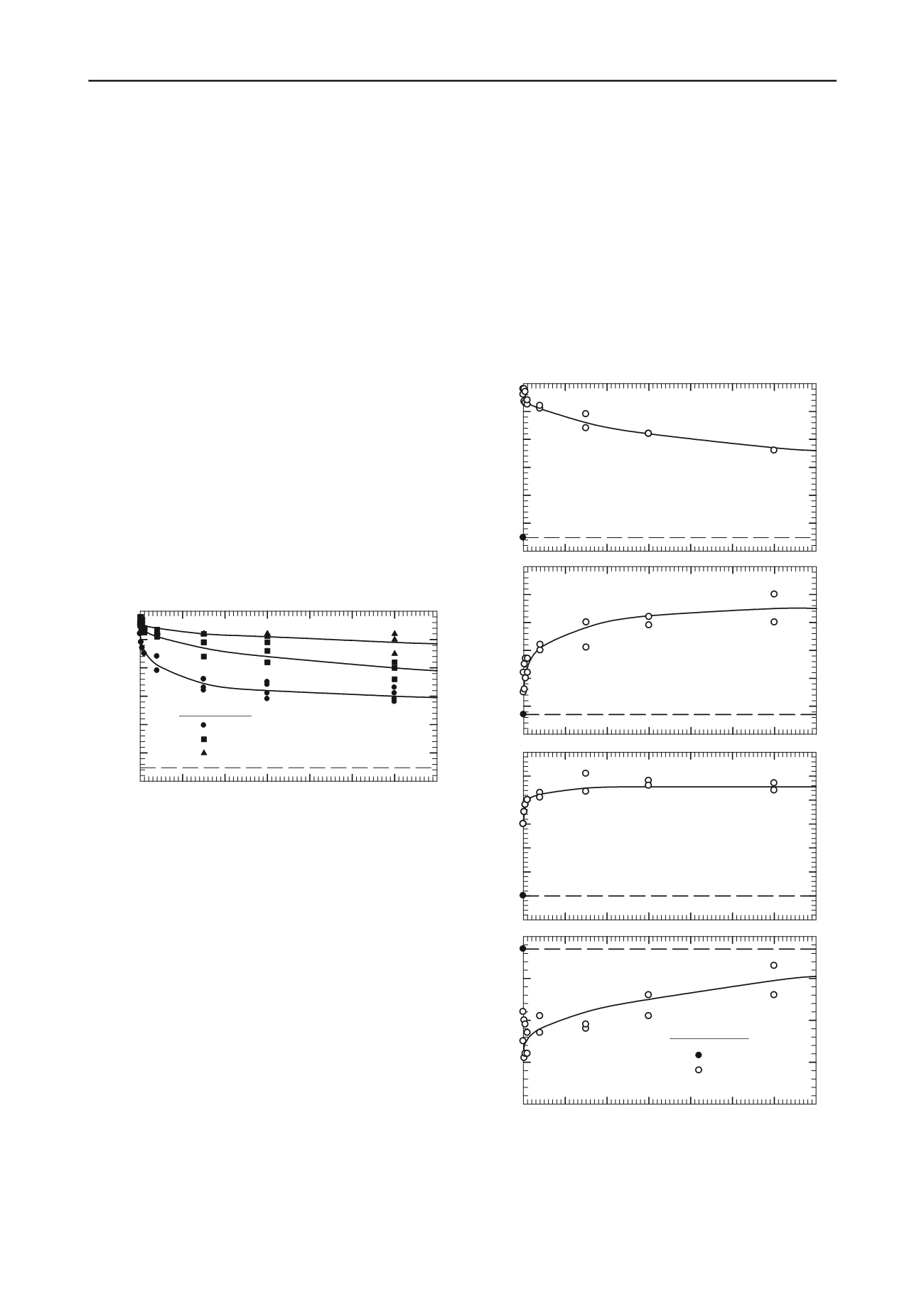
2555
Technical Committee 211 /
Comité technique 211
The pulverized clay was mixed with dry hydrated lime, and was
thoroughly rehydrated using distilled water. Two halves of the
pre-cut specimen were formed by remolding or compaction and
separately consolidated inside the top and bottom halves of the
shear box using the procedure described by Mesri and Cepeda-
Diaz (1986) and Mesri and Huvaj-Sarihan (2012). The
consolidation pressure ranged from 100 to 450 kPa, and shear
displacement rate was in the range of 3.3x10
-4
to 5x10
-4
mm/min.
Lime content as a percent of dry weight of clay ranged from
0 to 10%, and water content was in the range of 30 to 274%. In
a few direct shear tests, dry hydrated lime was sprinkled on the
exposed shear surface or on the top and bottom, of the direct
shear specimen to examine lime diffusion.
For one series of direct shear specimens with lime content
of 6.6%, liquid limit and plastic limit were determined at the end
of the test. These data are shown in Fig. 1. For another series
of lime-treated Brenna clay samples with lime content of 2, 5
and 9% and water content of 80, 100, 150 and 230%, pH and
Atterberg limits were measured as a function of time. These
samples were sealed; however, they were not subjected to
confining pressure. The pH measurements are shown in Fig. 2,
and the liquid limit and plastic limit at lime content of 5% and
water contents of 80 and 100% are shown in Fig. 3.
The data on residual friction angle and fully softened
friction angle from drained direct shear tests are summarized in
Table 1. All index tests and direct shear tests reported here were
performed at laboratory temperature of 20 ± 2
C.
Curing Time, days
0
10
20
30
40
50
60
70
PH
7
8
9
10
11
12
13
2
5
9
Untreated
Lime Content, %
Figure 2. pH measurements of lime-Brenna clay
5 INTERPRETATION OF THE MEASUREMENTS
The pH measurements on lime-treated Brenna clay, such as
those in Fig. 2 as well as others, show that immediately after
introduction of lime, pH increases to a range of 12.2 to 12.7;
shortly thereafter, however, pH begins to decrease. This
observed behavior suggests that either within hours no free lime
is left to dissociate to maintain pH above 12, or dissociated
(OH)
-
is simultaneously consumed by the silica and alumina
dissolved from Brenna minerals. Nevertheless, during the 60
day observation period, pH remained above 9 suggesting
continued lime-clay chemical reactions.
The rather immediate large increase in plastic limit above
that of the untreated Brenna clay, such as observed in Figs. 1
and 3 results from flocculation and agglomeration of lime-
treated clay, especially as the water content is reduced during
the plastic limit measurements. Rapid chemical attack of
adsorbed lime on clay particles contributes to the production of
porous flocs and agglomerates that entrap water.
When the curing of lime-Brenna clay takes place
unconfined, liquid limit dramatically increases above the liquid
limit of untreated clay (Fig. 3); whereas when curing takes place
under an imposed effective stress condition, such as the
n
in
the range of 100 to 450 kPa in the direct shear tests, there is a
minor increase in liquid limit (Fig. 1). The interpretation of this
significant observed behavior appears to be that when
aluminosilicates form in unconfined condition, they hydrate
fully, thus holding significant amount of water that contributes
to the high liquid limit. On the other hand when lime-clay
reaction products form under effective confining pressure, either
the resulting aluminosilicates do not hydrate much or they
experience irreversible dehydration through consolidation, thus
resulting in little change in the liquid limit. The implication of
this behavior, which is under more detailed examination, is
significant for both laboratory study of lime-soil interaction to
improve frictional resistance as well as field application of lime
to remediate reactivated landslides.
PH
7
8
9
10
11
12
13
Untreated
Water Content, %
30
40
50
60
70
80
90
100
Untreated
Plastic Limit
80
90
100
110
120
130
140
Untreated
Liquid Limit
Curing Time, days
0
10
20
30
40
50
60
70
10
20
30
40
50
0
5
Untreated
Lime Content, %
Plasticity Index
Figure 3. Lime-Brenna clay interaction under unconfined condition
The fully softened friction angle and residual friction angle
of stiff clays and shales decrease with the increase in effective
normal stress (Mesri and Shahien 2003, Mesri and Huvaj-
Sarihan 2012 ). The secant friction angles of Brenna clay in


